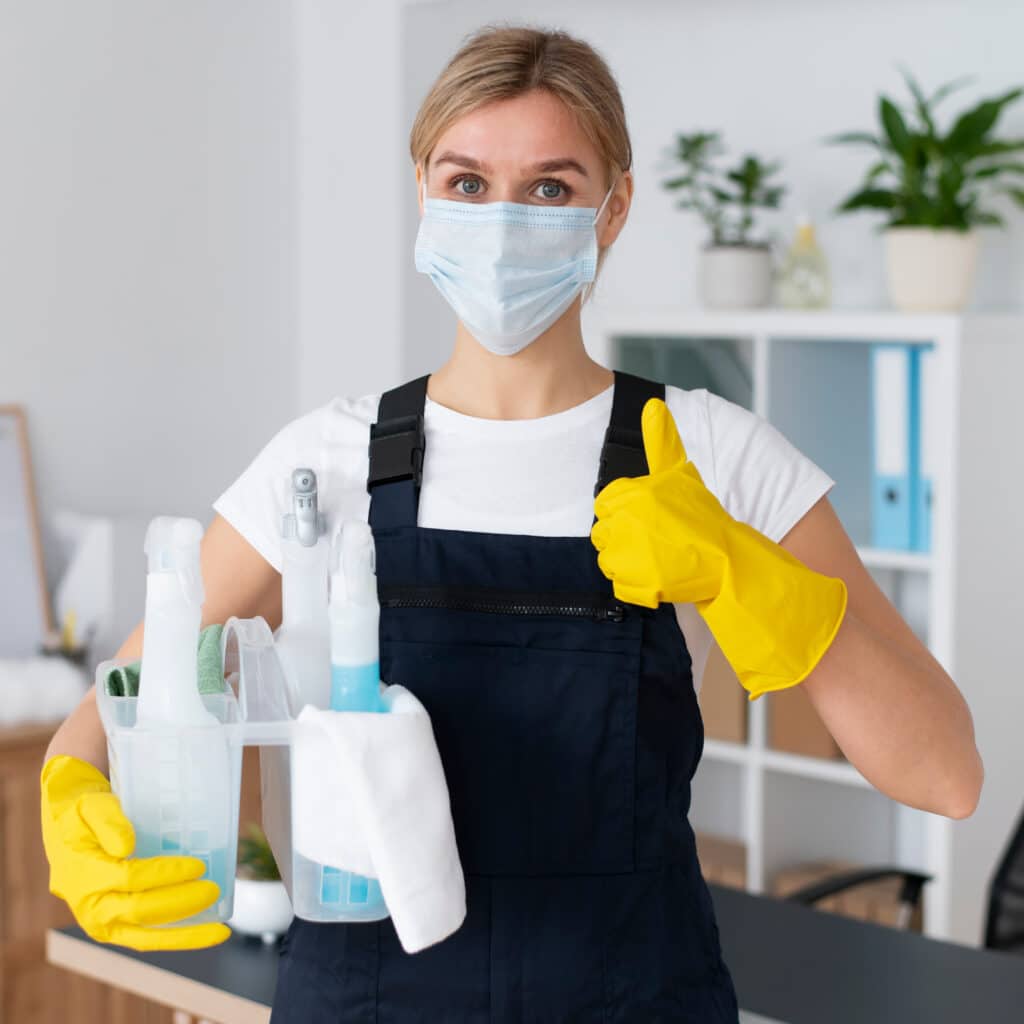Effective Communication: Setting Expectations with Clients

By the CHC Association
Introduction
The housecleaning industry, while often viewed through the lens of the physical act of cleaning, is deeply rooted in the nuances of human interactions. As service providers, housecleaners don’t just engage with spaces, but with people and their personal sanctuaries. In this context, the relevance of seamless communication cannot be overstated. Clear, effective communication ensures harmonious working relationships, while also setting the stage for consistent service delivery. A study by the Customer Communication Group sheds light on this aspect, revealing that clear communication can bolster customer satisfaction by an impressive 40%.
The Importance of Setting Expectations
In a sector where trust is paramount, aligning and managing expectations stands as a linchpin.
-
Client Retention: Aligning deliverables with client expectations is synonymous with bolstered loyalty. Research from the Harvard Business Review identifies that businesses that navigate this realm proficiently can achieve a commendable 85% client retention rate, epitomizing the value of robust relationships.
-
Minimizing Conflicts: Synchronized expectations are antidotes to potential discord. Validating this, the Service Management Group reports a 35% conflict reduction in businesses that embrace unwavering transparency from the outset.
-
Quality Assurance: Delivering top-notch service quality extends beyond adept cleaning—it encapsulates the continual realization of client expectations. A Gallup survey demonstrates that businesses operating with this dual-focus witness a 20% boost in referrals, accentuating their reputation.
Step-by-Step Guide to Setting Expectations with Clients:
-
1. Transparent Initial Consultation
-
Discuss Service Offerings: Clearly outline what services are offered, going into the specifics to avoid ambiguity.
-
Limitations and Boundaries: Discuss the extent of the services provided, ensuring clients have realistic expectations.
-
Discuss Possible Challenges: Every home has unique elements. Discussing potential challenges ensures clients are prepared for any deviations from the norm.
-
Collaborative Decision Making: Engage clients in decisions regarding cleaning methods or products, building a sense of involvement.
-
-
2. Written Service Agreement
-
Detailed Breakdown: Ensure the agreement covers all aspects of the service in detail to minimize potential conflicts.
-
Clarity on Pricing: A clear breakdown of costs prevents misunderstandings and potential disputes later.
-
Flexible Clauses: Address scenarios such as cancellations, rescheduling, or extra services.
-
Review Periodically: Regularly updating the service agreement ensures it remains relevant and aligned with both the business and client needs.
-
-
3. Regular Feedback Loops
-
Scheduled Check-ins: Regularly scheduled sessions for feedback foster a sense of involvement and trust.
-
Act on Feedback: Active responses to feedback showcase commitment and professionalism.
-
Feedback Evolution: Ensure the feedback process itself evolves, staying aligned with changing client needs and industry standards.
-
Encourage Candidness: Emphasize the importance of candid feedback, ensuring clients feel comfortable sharing both positives and areas of improvement.
-
-
4. Flexible Service Customization
-
Adaptable Offerings: Recognize that every household is unique, and their requirements can vary. By offering adaptable services, businesses can cater to specific client needs.
-
Client-Centric Packages: Designing service packages based on individual client feedback ensures they receive optimal value.
-
Open Discussion Forums: Regularly hosting sessions where clients can voice specific service needs can drive customization efforts.
-
Service Evolution: As the industry evolves, ensuring services can adapt to new client demands solidifies long-term relationships.
-
-
5. Prioritize Safety and Trust
-
Safety Protocols: Demonstrating a commitment to safety – both in terms of products used and the conduct of staff – underpins client trust.
-
Background Checks: Regular background checks of staff members assure clients of their safety.
-
Transparent Product Usage: Sharing information about cleaning products, especially in terms of environmental and health impacts, emphasizes transparency.
-
Safety Training: Continuous training sessions focusing on safety protocols ensure that every staff member adheres to the highest safety standards.
-
-
6. Acknowledge and Act on Mistakes
-
Immediate Admission: Owning up to mistakes rather than deflecting responsibility showcases integrity and accountability.
-
Structured Redressal: Having a systematic process in place to address and rectify mistakes prevents recurrence and demonstrates professionalism.
-
Open Communication: Keeping clients in the loop during the rectification process fosters trust and transparency.
-
Feedback Post-Rectification: Seeking client feedback post redressal provides insights into improving future actions.
-
-
7. Value-Added Services
-
Offer More than Cleaning: By providing additional services, such as organizing, businesses can enhance client relationships and stand out in the market.
-
Client Surveys: Regular surveys to understand which additional services clients value the most can guide service expansion.
-
Packages and Discounts: Bundling value-added services with regular offerings can entice clients and enhance perceived value.
-
Continuous Service Improvement: Monitoring the performance of value-added services ensures they remain up to the mark and relevant.
-
-
8. Update Clients on Changes
-
Timely Information: Any changes, be it in staff, products used, or services offered, should be promptly communicated to clients.
-
Open Discussion Platforms: Hosting forums where clients can discuss and provide feedback on changes ensures they feel involved.
-
Educational Approach: When introducing new products or methods, educating clients on their benefits fosters acceptance and trust.
-
Feedback Integration: Taking client feedback into account when implementing changes ensures they remain aligned with client needs and preferences.
-
-
9. Diversify Communication Channels
-
Multiple Platforms: Offer communication via phone, email, messaging apps, and face-to-face.
-
Choose Best Medium: Understand each client’s preference for communication, and use that channel when reaching out.
-
Scheduled Updates: Regularly provide clients with updates about any ongoing changes or improvements in the services.
-
Stay Updated: As technology evolves and new communication platforms emerge, be quick to adopt them to stay connected with a diverse clientele.
-
-
10. Regularly Revisit Expectations
-
Periodic Reviews: Set times during the year to revisit and potentially recalibrate expectations.
-
Feedback Integration: Use these review sessions to integrate any feedback received throughout the year.
-
Stay Updated: With industry standards and client needs evolving, ensure the expectations set remain relevant.
-
Open Discussions: Encourage clients to openly discuss any shifts in their expectations during these reviews.
Implementing Client Expectations:
-
Employee Training
-
Ongoing Learning: Regularly update staff with the latest cleaning techniques and customer service skills.
-
Feedback Integration: Use client feedback to guide training sessions, ensuring alignment with client needs.
-
Certification: Encourage staff to gain industry certifications, enhancing their skill sets and the company’s reputation.
-
Soft Skills: Emphasize the importance of communication, understanding, and empathy in training programs.
-
-
Utilize Technology
-
Booking Systems: Implement user-friendly booking systems for clients to easily schedule or reschedule their appointments.
-
Feedback Platforms: Use technology to gather and analyze client feedback systematically.
-
Communication Channels: Offer multiple channels – from emails to messaging apps – ensuring clients can communicate at their convenience.
-
Stay Updated: As technology evolves, ensure your business tools remain current, offering clients the best possible experience.
-
-
Open Door Policy
-
Ease of Communication: Clients should feel they can communicate grievances, feedback, or requirements without hurdles.
-
Immediate Addressal: An open-door policy isn’t just about listening; it’s about acting on what’s heard.
-
Build Trust: Such policies emphasize that client voices are valued, fostering trust.
-
Regular Reviews: Periodically review the open-door policy, ensuring it serves its intended purpose and evolves as needed.
-
-
Feedback Mechanism
-
Clear Platforms: Establish structured platforms where clients can provide their feedback seamlessly.
-
Evolutionary Mechanisms: Ensure that feedback systems evolve with technological advances and changing client behaviors.
-
Swift Responses: Address feedback promptly, showing clients that their opinions are valued.
-
Integrate Insights: Use the feedback to refine services and enhance client satisfaction continuously.
-
-
Transparency in Billing
-
Itemized Bills: Offer clients detailed, itemized bills to eliminate any confusion regarding service costs.
-
Query Redressal: Establish a quick response system for any billing queries or disputes.
-
Periodic Overviews: Give clients periodic overviews of their expenditure, aiding their financial planning.
-
Flexible Payment Options: With technology driving financial transactions, ensure multiple payment options are available for client convenience.
-
-
Regular Training Programs
-
Skill Upgradation: Regular training sessions ensure that staff skills remain updated with industry standards.
-
Soft Skills Enhancement: Beyond technical abilities, emphasize interpersonal skills, fostering better client relationships.
-
Feedback-based Training: Design training modules based on client feedback, directly addressing their concerns.
-
Certification Drives: Organize periodic drives for staff to achieve higher industry certifications, enhancing service quality.
-
-
Accessible Customer Service
-
Multiple Channels: Offer clients multiple channels to reach out, from phone lines to chatbots.
-
Swift Redressal: Ensure that client queries or concerns are addressed promptly.
-
Feedback Loop: Use interactions as an opportunity to gather feedback, refining services further.
-
Continuous Training: Regularly train customer service staff, ensuring they’re equipped to handle all client queries effectively.
-
-
Client Onboarding Process
-
Structured Approach: A streamlined onboarding process sets the tone for the entire client relationship.
-
Welcome Kits: Offer clients welcome kits, acquainting them with the services and establishing a warm relationship.
-
Feedback Points: Embed feedback opportunities throughout the onboarding process, ensuring immediate refinements if needed.
-
Ongoing Evolution: As client needs and industry standards evolve, ensure the onboarding process remains updated.
-
-
Technology Integration
-
Adopt Latest Tools: From booking to feedback, employ the latest technologies to enhance the client experience.
-
Mobile Platforms: With clients increasingly mobile, offer platforms optimized for smartphones and tablets.
-
Security Emphasis: Given the online nature of many interactions, ensure robust cybersecurity measures are in place.
-
Continuous Updates: Regularly update technological tools, ensuring they remain glitch-free and user-friendly.
-
-
Client Retention Initiatives
-
Loyalty Programs: Introduce loyalty programs, rewarding clients for their continued association.
-
Regular Check-ins: Beyond service delivery, check in with clients to understand their evolving needs and expectations.
-
Special Offers: Periodically offer clients special deals or additional services, cementing the business relationship.
-
Feedback-driven Initiatives: Design retention initiatives based on client feedback, directly addressing their desires and concerns.
Handling the intricacies of client relationships in the housecleaning industry requires a delicate balance between assertiveness and understanding. By setting clear expectations and investing in mechanisms that prioritize the client experience, businesses not only enhance their service delivery but also foster long-lasting relationships. Implementing robust systems, being open to feedback, and continuously updating both skills and technology underline a commitment to excellence. As professionals in this space, it’s imperative to realize that every client interaction is an opportunity—an opportunity to learn, refine, and grow. By valuing each client’s unique perspective and ensuring that their expectations align with service delivery, housecleaning businesses can achieve unparalleled success and set new industry standards.




Responses